Prep. Lesson 21. Exploring high and low sounds II
Prior learning: None
Duration: 30 minutes
Materials: Tuned and untuned percussion
Keywords: Beat, singing, chanting, partners, rhymes, circle games
Difficulty: ![]()
 Melodic development
Melodic development
![]() Students sing a new variation of a song that draws attention to three notes, tonic, 5th and octave.
Students sing a new variation of a song that draws attention to three notes, tonic, 5th and octave.
- Teach the song using the echo technique and incorporate body movements:
- Sing each phrase of the song, having students echo after you.
- For the first phrase, touch heads while singing "I can sing high." Ensure students follow suit.
- For the second phrase, students will touch their knees while singing "I can sing low." Observe students mimicking the action.
- During the third phrase, students will touch their waist while singing, "Now I'm in the middle, and I don't know where to go."
- Encourage students to synchronise their movements.
- For the final phrase, move hands from waist to head during the glissando from A to C, and have students imitate this motion.
- Repeat the process until students can confidently sing the song and perform the corresponding body movements simultaneously, fostering better coordination and musical understanding.
This song builds upon the first version of this song, where the jump between notes ("my voice goes here") was an octave.
Now the jump is a fifth, and students learn that there is a high, low, and middle sound.
If students have difficulty pitching the notes, a fun game is "Put your voices in the elevator" (or roller coaster).
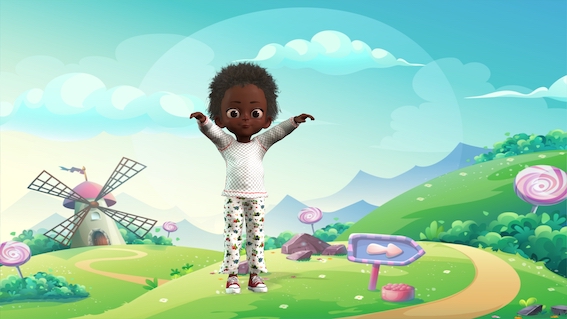
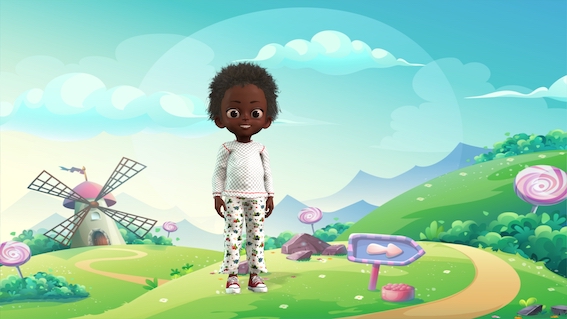
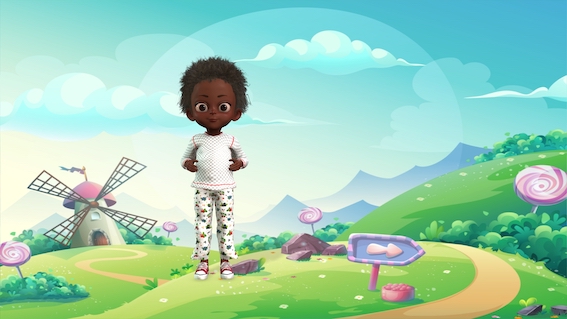
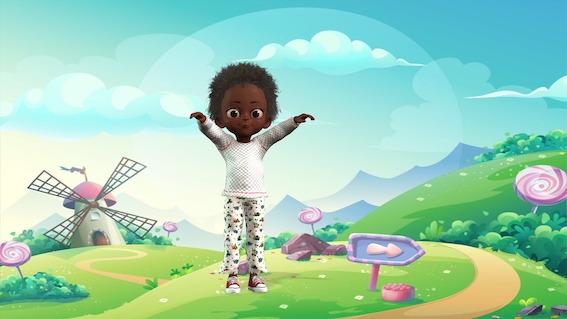
Note: in 2nd repeat, the note is low, and students' hands should drop down to their legs as in image 1.
 Rhythmic development
Rhythmic development
![]() Students discover how many sounds are in their name and use them to understand rhythm patterns.
Students discover how many sounds are in their name and use them to understand rhythm patterns.

Students learning rhythm using their names involves integrating language skills and musical elements.
This approach capitalises on children's innate familiarity with their names, making it an effective strategy to introduce the concept of rhythm, an essential aspect of music.
This method treats each syllable in a child's name as a sound. It's a strategy that combines linguistic and musical learning, promoting overall cognitive development in children.
- Students are seated and attentive. Ask a volunteer to say their name. Ask how many sounds are in their name.
- For example, a name like "Jonathan," with three syllables ("Jo-na-than"), it can be broken down into a three-sound rhythm.
- Students speak, clap, stomp, or use musical instruments like tambourines or drums to create these rhythms.
- The variation in the number of syllables across different names introduces the idea of rhythm patterns. For example, "Emily" (two syllables) would have a different rhythm pattern compared to "Christopher" (three syllables).
- You can use this strategy to create rhythm patterns in a group setting, where each child participates by saying or clapping out the rhythm of their name in turn, creating an interactive, engaging, and educational experience.
 Game
Game
![]() Students sing and use their arms to demonstrate their understanding of high and low notes.
Students sing and use their arms to demonstrate their understanding of high and low notes.
- Introduce the song "See Saw" to the class, demonstrating arm movements to reflect pitch changes.
- Sing "See Saw" for the students, illustrating the arm movements: arms at 90 degrees when the pitch is high and close to the body when the pitch is low.
- Instruct students to mimic the arm movements while singing along, maintaining the beat and coordinating their movements with the melody.
- Emphasise the relationship between the arm positions and the song's corresponding high and low pitches.
- For an engaging extension, distribute scarves or ribbons to students if available.
- Arrange students in a circle and instruct them to move around while waving their scarves or ribbons up and down, following the pitch contour of the song as they sing.
- Encourage students to focus on the connection between the movements, the beat, and the pitch, enhancing their overall musical understanding and performance skills.
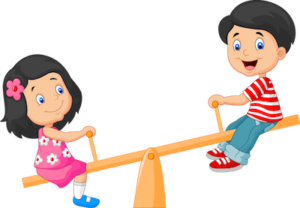
 Part work
Part work
![]() Students will use tuned percussion to demonstrate their understanding of high and low notes.
Students will use tuned percussion to demonstrate their understanding of high and low notes.
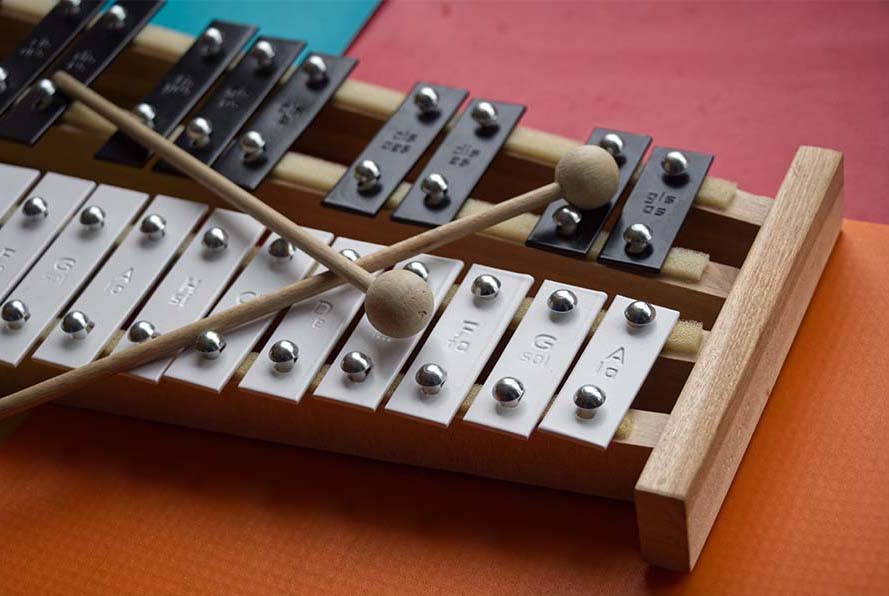
- Bring a student to the front and, using a xylophone, glockenspiel, or another tuned percussion instrument, guide them to play a low note followed by an octave higher note.
- Have the class identify which note was low and which was high.
- Repeat with another student, instructing the class to crouch for low sounds and stretch up for high sounds.
- Demonstrate high and low sounds using arm movements: touch heads for high sounds and shoulders for low sounds.
- Have students practice identifying high and low sounds while following the corresponding arm movements.
- Continue with additional students as time allows, reinforcing the concepts of high and low sounds and their associated physical representations.
 Visual learning
Visual learning
![]() Students discover more about high, low and in the middle using visual learning.
Students discover more about high, low and in the middle using visual learning.
- Project the images on the board.
- Ask students if they can tell which child is high and which is low.
- Do the same for the image of coloured balls.
- Ask students if they can tell if a child/ball is in the middle.

Which child is high?
Which child is low?
Which child is in the middle?

Which ball is high?
Which ball is low?
Which ball is in the middle?
 Listening
Listening
![]() Students have fun listening to a story about high and low!
Students have fun listening to a story about high and low!
Slim, Wally and Kip explore high and low.
Once upon a time, in the most delightful part of a magical forest, there lived a snail named Slim, a wombat named Wally, and a kangaroo named Kip. These three friends were curious about the ideas of high and low, but they were too busy chuckling at the forest's amusing antics to explore further.
One bright day, as they were laughing at a butterfly chasing a moth, they decided to go on an adventure to uncover the mystery of high and low. And so, with hearts full of excitement, Slim the Snail, in true snail fashion, moved slower than a slug in a bubble bath. Wally the wombat waddled like a duckling on a pogo stick, and Kip the kangaroo hopped like a bouncing bunny.
The three friends stumbled upon a tall tree with a bird's nest on the highest branch. Kip, a champion of leaps and bounds, hopped up to the nest and shouted, "Look, guys! This is high, like the sky's tippy-toes!"
Slim and Wally gazed up, their eyes widening with amazement. "Golly, Kip! You're right! That's as high as the sky's tippy-toes!" they exclaimed.
As the friends continued their adventure, they discovered a burrow that went so deep they couldn't see the bottom. Wally, an expert on all things underground, declared, "This burrow is low, like the Earth's secret sock drawer!"
Slim and Kip peeked into the burrow, and Kip gasped, "Jumpin' jellybeans, Wally! You've cracked the code! This is low, like the Earth's secret sock drawer!"
And so, with newfound knowledge and a dash of silliness, Slim, Wally, and Kip completed their adventure, understanding the difference between high and low. They returned to their giggly forest home, ready to share their discoveries with their forest friends and keep laughing at the endless supply of wonderful surprises nature had in store for them.
 Farewell
Farewell
![]() Reinforces students' pitch ability through listening, imitation, and repetition. 'Good morning' or 'Bee, Bee, Bumblebee' are good examples.
Reinforces students' pitch ability through listening, imitation, and repetition. 'Good morning' or 'Bee, Bee, Bumblebee' are good examples.
